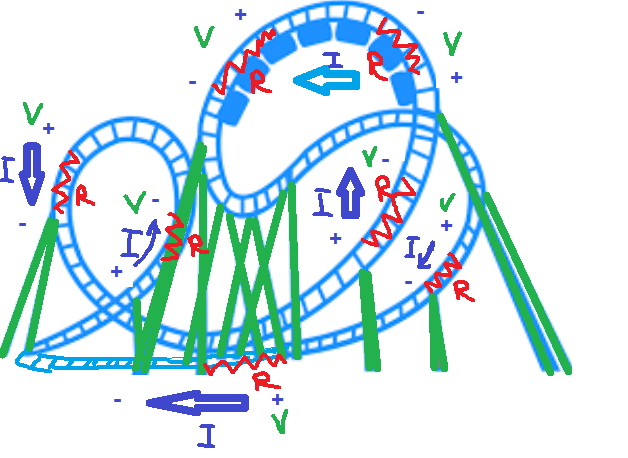
The Laws of Circuit - you can learn and practice by just
reading
copyright. Charles Kim 2006
-
- KVL (Kirchhoff's
Voltage Law) and Roller Coaster Ride
-
- I hate roller coaster. Actually I do not.
I hate riding roller coaster. I still do not understand
those riding and enjoying folks in the numerous amusement
parks. I did ride a roller coaster once and instantly I
decided to hate riding one. That's a million years ago,
anyway. However, riding roller coaster could help you
better understand KVL (Kirchhoff's Voltage Law).
-
- KVL first. KVL is about voltage. In other
words, the sum of voltages surrounding a loop in a
circuit must be zero. The tricky point here is that each
voltage in the loop should carry a sign with its value in
the algebraic sum equation. In other words, the algebraic
sum equation should look like: (+V1)+(+V2)+(-V3)+(-V4)=0
or (+20)+(+2)+(-2)+)+(-20)=0. The question is how do we
determine the signs of the voltages. So let's ride a
roller coaster, minus me.
-
- A roller coaster is not roller coaster if
there is no climbing up and climbing down, with very high
speed. Actually the ride does not have any flat track
span. Otherwise, it would not attract any riders except
me. Side bar: Voltage is a potential difference between
two points. Higher potential side is marked with plus or
positive (+) polarity, and the lower side, minus or
negative (-) polarity. The voltage can be a voltage
source with given value and polarities in the circle
symbol, or a voltage developed across a resistor, or a
voltage across a current source. Another side bar:
negative power indicates supplied power and positive
power consumed power. At least the convention in circuit
theory in the U. S.
-
- Back to the roller coaster. In the
climbing up track span, it needs energy to pull it up to
higher position. In the down track span, it consumes the
energy gained from the up drive. In the ride, you meet
many voltages: voltage source, voltage across a resistor,
voltage across another resistor, or voltage across a
current source. A voltage must have polarities: + and -.
When the roller coaster rides along the loop, it goes in one direction,
whether climbing up or dropping down.
-
-
 In KVL
once you choose which direction your roller coaster runs
(clockwise or counterclockwise) on the loop, you should
not change the direction in the middle of your ride.
Never. Butyou can select the direction of
your ride before your start. The direction of the roller coaster
can be thought as the current flow direction in a circuit loop.
In KVL
once you choose which direction your roller coaster runs
(clockwise or counterclockwise) on the loop, you should
not change the direction in the middle of your ride.
Never. Butyou can select the direction of
your ride before your start. The direction of the roller coaster
can be thought as the current flow direction in a circuit loop.
-
- By the way, how and who determines the
voltage polarity at the first before applying KVL? You.
Basically you do on almost all voltages in the circuit.
Except one. Voltage source: independent or dependent.
Since voltage sources come with polarity of + and -, you
have to honor them. On a resistor, you can first
determine the current flow direction and you follow the
voltage polarity honoring the passive convention. Or you
simply decide your voltage polarity first and let the
current flow direction flow according to the passive
convention. All right. Now welcome aboard KVL and sit
back and relax for a wild ride. And I am watching you up.
-
- WWW.MWFTR.COM
